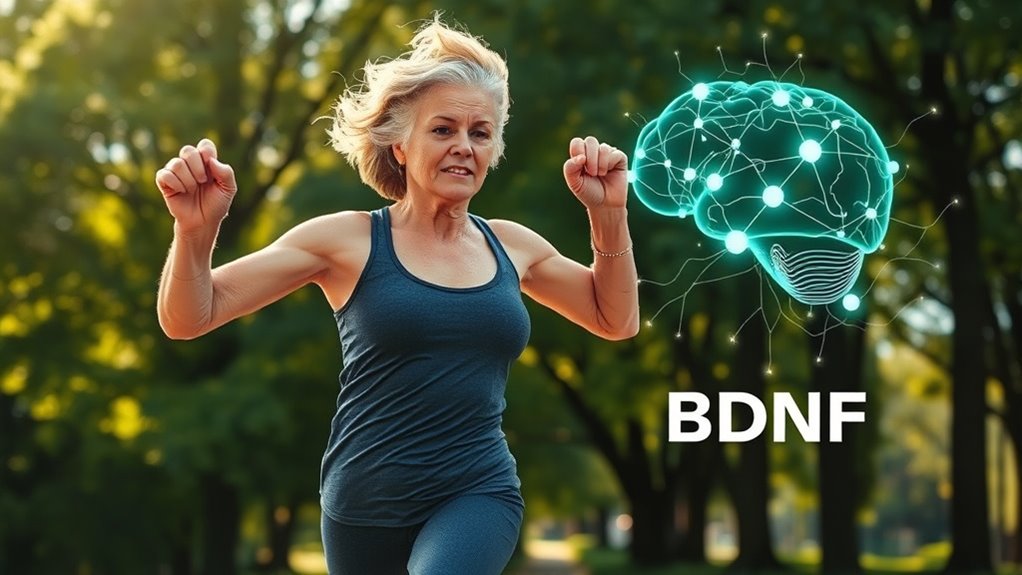Regular exercise after 40 helps preserve brain volume, especially in key areas like the hippocampus, which supports memory and learning. It boosts blood flow, reduces inflammation, and stimulates the growth of new neurons through factors like BDNF. This combination enhances cognitive clarity, quickens response times, and protects against age-related decline. Staying active consistently can markedly improve your mental health now and in the future. Keep exploring to discover effective ways to tap into these benefits long-term.
Key Takeaways
- Exercise preserves brain volume and promotes neurogenesis, especially in critical areas like the hippocampus, supporting memory and learning after 40.
- Physical activity increases BDNF levels, enhancing synaptic plasticity, neurogenesis, and cognitive resilience.
- Regular exercise improves vascular health, ensuring better blood flow and nutrient delivery to the brain.
- Exercise reduces inflammation and neurodegeneration, protecting against age-related cognitive decline and dementia.
- Immediate mood boosts and increased processing speed from exercise enhance mental clarity and quick thinking.
How Physical Activity Preserves Brain Structure With Age

As you age, your brain naturally experiences volume loss, particularly in areas like the hippocampus that are essential for memory and learning. Regular physical activity helps slow this process by promoting brain plasticity and preserving neural integrity. Exercise, especially aerobic activities, improves vascular health, which guarantees better blood flow and nutrient delivery to brain tissue. It also stimulates neurogenesis, particularly in the hippocampus, supporting new neuron growth. Higher fitness levels are linked to less brain atrophy in key regions, helping maintain cognitive functions longer. Even in older adults, consistent activity can mitigate structural decline, protecting against neurodegenerative changes. Engaging in physical activity can also enhance brain connectivity and improve overall cognitive resilience in aging populations. Additionally, physical activity can promote mental health by reducing symptoms of anxiety and depression, which are often associated with aging. While some brain areas are more responsive than others, overall, staying active supports brain structure and function throughout aging.
Cognitive Benefits of Regular Exercise for Middle-Aged Adults

Regular physical activity offers notable cognitive benefits for middle-aged adults, helping to keep your mind sharp as you age. Engaging in regular movement, whether through walking, household chores, or exercise routines, can boost your processing speed, making you quicker at thinking and responding. These benefits can occur immediately, regardless of activity intensity, and increase with consistent effort. Over the long term, exercise reduces the risk of cognitive decline and dementia. Both aerobic and resistance exercises improve overall cognition, and combining different activities may enhance these effects. Exercise also decreases inflammation, which can benefit brain health. Maintaining a routine of daily movement and staying active regularly supports your cognitive flexibility, response times, and overall mental sharpness as you grow older. Incorporating mental and emotional well-being practices alongside physical activity can further amplify these cognitive benefits. Additionally, regular exercise helps to promote neuroplasticity, which is vital for maintaining learning and memory functions over time. Engaging in consistent exercise routines can also foster better brain connectivity, leading to improved communication between different brain regions. Moreover, staying physically active has been linked to supporting brain blood flow, which is essential for nourishing brain cells and maintaining cognitive health over the years. Furthermore, exercise can enhance mental resilience, enabling better stress management and emotional stability.
Molecular Pathways: The Role of BDNF in Brain Health

When you exercise, your brain responds by increasing BDNF levels, which directly enhances synaptic plasticity. This boost helps strengthen connections between neurons, supporting better memory and learning. Understanding how BDNF mediates these effects reveals why staying active is essential for brain health after 40. Additionally, physical activity can stimulate sound vibrations that influence brainwave patterns, further promoting cognitive vitality.
BDNF and Synaptic Plasticity
Brain-derived neurotrophic factor (BDNF) plays an essential role in synaptic plasticity, especially in the hippocampus where learning and memory occur. You need BDNF to maintain long-term potentiation (LTP) at hippocampal synapses; without it, memory formation suffers. BDNF encourages structural changes like spine enlargement and boosts proteins such as Homer2b, strengthening connections. It also stimulates local dendritic production of cytoskeleton-related proteins like RhoA and LIMK1, supporting synaptic remodeling. BDNF influences the trafficking and phosphorylation of NMDA receptors, fundamental for synaptic consolidation. It impacts both glutamatergic and GABAergic synapses, balancing excitation and inhibition. Overall, BDNF’s signaling pathways promote dynamic structural and functional synaptic changes essential for learning, memory, and cognitive resilience.
Exercise-Induced BDNF Increases
Exercise triggers a notable increase in BDNF levels, which directly supports brain health and cognitive function. When you exercise, BDNF binds to TrkB receptors, activating pathways like PI3K/Akt that promote neuronal survival and plasticity. This boost in BDNF enhances neurogenesis by encouraging neural stem cell growth and survival, helping your brain adapt and recover. The increase also stimulates pathways such as Ras/Erk, supporting cell proliferation and differentiation. As a result, synaptic connections strengthen, dendritic spines grow, and memory improves. Elevated BDNF levels are linked to increased gray matter volume and better white matter integrity, protecting your brain from age-related decline. Additionally, proper regulation of color accuracy and contrast ratio is essential for optimal cognitive processing during visual tasks. Overall, exercise-induced BDNF increases are crucial for maintaining cognitive resilience and mental health after 40.
Immediate and Short-Term Cognitive Boosts From Exercise

When you exercise, you’ll notice quick mood boosts and improved processing speed that make daily tasks feel easier. Even a single workout can give you immediate cognitive benefits, helping you think more clearly and feel more alert. These short-term gains can motivate you to stay active and support your brain health over time. Additionally, engaging in regular activity with a performance kit can enhance your overall mental well-being by fostering a sense of routine and accomplishment. Incorporating activities that promote cell turnover can also help boost brain function by improving overall health and resilience. Using the right training techniques can further optimize these benefits and protect your cognitive health as you age. Moreover, creating a dedicated remote work environment that encourages movement and activity can further support these cognitive boosts throughout your day.
Quick Mood Improvements
Engaging in moderate physical activity can lead to quick improvements in mood that boost your mental clarity and emotional well-being. Even just five minutes of exercise can lift your spirits, reducing tension, anger, depression, and confusion. These mood boosts aren’t fleeting; they can last up to a day, helping you feel more balanced and resilient. You might notice a better outlook and increased motivation shortly after exercising. Additionally, incorporating mental health benefits into your routine can enhance your mental health and provide a pleasant mental escape.
Enhanced Processing Speed
Even a brief burst of physical activity can immediately boost your cognitive processing speed, making your mind sharper within hours. Whether you walk, do chores, or jog, these activities enhance mental speed, similar to reversing four years of cognitive aging. The boost happens regardless of intensity or duration, so even quick workouts or movement breaks count. Engaging in physical activity throughout the day amplifies these benefits, helping you stay alert and quick-thinking. Research shows that just five minutes of moderate-to-vigorous exercise can improve processing speed and executive function, especially in middle-aged adults. Neurobiological changes—like increased blood flow and brain activity—support faster neural communication. Real-time assessments confirm these effects are temporary but can accumulate with consistent movement, maintaining sharpness in your daily life. Additionally, incorporating physical activity into your routine can promote overall brain health and reduce cognitive decline over time. Regular movement also helps prevent decreased airflow, ensuring the brain receives fresh blood and oxygen for optimal function.
Immediate Cognitive Gains
Physical activity can deliver immediate cognitive benefits, boosting your mental sharpness almost instantly regardless of how intense or long the exercise is. When you move, your brain responds quickly, improving response times and mental clarity. This boost happens because exercise increases blood flow, supporting brain function and releasing neurotrophic factors like BDNF that promote neuronal health. Even moderate activity can elevate your mood and sharpen your focus in the short term. Neurotrophic factors play a crucial role in supporting neuronal growth and resilience, further enhancing cognitive benefits. Regular movement also encourages the development of healthy brain plasticity, making your brain more adaptable and efficient. Incorporating exercise routines tailored to your needs can maximize these immediate cognitive effects. Leveraging AI content clusters can help you develop targeted strategies to optimize your exercise routines for cognitive health. Consistent movement, no matter the intensity, enhances cognitive flexibility and helps maintain cortical integrity as you age.
Long-Term Effects of Consistent Exercise on Brain Volume and Function

Consistent exercise over the long term can considerably enhance brain volume and function, especially as you age. Regular aerobic activity increases hippocampal volume, which boosts memory and learning capabilities. It also influences cortical regions involved in critical cognitive processes, although results vary. Exercise promotes neuroplasticity, helping your brain adapt and grow throughout life, and reduces brain atrophy linked to aging, preserving cognitive health. Long-term physical activity particularly benefits older adults by slowing hippocampal shrinkage and supporting cognitive functions. Evidence from studies shows that consistent exercise can mitigate age-related memory decline and enhance executive functions like planning and problem-solving. These benefits are driven by improved blood flow, reduced inflammation, and increased neurotrophic factors, all working together to protect and strengthen your brain over time.
Effective Exercise Types for Enhancing Brain Performance

To boost your brain performance after 40, choosing the right types of exercise is essential. Different activities target various brain functions and promote neural health. Aerobic exercises like walking and cycling increase brain volume, especially in memory-critical regions like the hippocampus, and improve attention and processing speed. Resistance training enhances cognitive and executive functions, supporting neural plasticity. Multi-component programs combine aerobic, resistance, and balance exercises, offering the most extensive benefits by engaging multiple brain areas simultaneously. Mind-body exercises such as Tai Chi and yoga improve executive functions, attention, and emotional regulation through mental focus and stress reduction. Incorporating these varied exercises into your routine maximizes cognitive benefits and helps sustain long-term brain health.
Diverse exercises like aerobic, resistance, and mind-body boost brain health and promote long-term cognitive resilience after 40
- Boost neural plasticity and brain volume
- Engage multiple brain regions simultaneously
- Improve mood, focus, and stress management
- Support long-term cognitive resilience
Practical Tips for Incorporating Brain-Boosting Exercise Into Daily Life

Incorporating brain-boosting exercise into your daily routine is easier than you might think, especially when you treat it as a habit rather than a chore. Start small—just a few minutes daily—and gradually increase your activity by 5–10 minutes each week. Establish a consistent routine, like walking after dinner or taking the stairs, to build long-term habits. Use tools like smartphone apps or journals to track your progress, which keeps you motivated. Incorporate everyday activities, such as walking during calls or parking farther away, to increase movement. Pair physical activity with mental challenges, like learning new skills, for added benefits. Leverage technology and social support to stay accountable and motivated, making brain-boosting exercise a natural part of your daily life.
Frequently Asked Questions
Can Exercise Help Prevent Age-Related Neurodegenerative Diseases?
You might wonder if exercise can prevent age-related neurodegenerative diseases. The answer is yes. Regular physical activity reduces harmful proteins linked to Alzheimer’s and Parkinson’s, improves brain energy metabolism, and enhances neuroplasticity. It also supports vascular health, lowers inflammation, and boosts neurotrophic factors. By staying active, you help protect your brain, improve cognition, and potentially slow or prevent the progression of neurodegenerative conditions as you age.
How Quickly Can I See Cognitive Improvements After Starting Exercise?
When you start exercising, you can notice cognitive improvements pretty quickly. Even after just one session, your brain’s processing speed and executive functions may improve temporarily. If you stick with regular activity, these benefits become more lasting, often within 8 weeks. Consistent exercise boosts brain connectivity and neuroplasticity, helping you stay sharp longer. So, with commitment, you’ll see both immediate and long-term mental gains.
Is Resistance Training as Effective as Aerobic Exercise for Brain Health?
Think of your brain as a garden that needs both sunlight and water to thrive. Resistance training can be just as effective as aerobic exercise for your brain health, helping improve cognitive function and inhibit decline. Combining both types offers a well-rounded approach, boosting blood flow, neuroplasticity, and muscle strength. So, don’t choose one—embrace variety to give your mind the best chance to flourish after 40.
What Are Some Enjoyable Ways to Stay Physically Active Regularly?
You can stay active regularly by choosing activities you enjoy. Gardening relaxes your mind and keeps you moving, while dancing boosts mood and coordination. Playing outdoor games or pickleball offers fun social ways to stay fit. Joining Zumba classes or cycling groups keeps things energetic and social. Household chores, yard work, or brisk walking are easy daily options. Find what excites you, and make it part of your routine for lasting health benefits.
Does Mental Engagement During Exercise Enhance Its Brain Benefits?
Like adding spice to a dish makes it more flavorful, mental engagement during exercise enhances its brain benefits. When you challenge your mind with activities like tai chi or learning new movements, you stimulate your brain more effectively. This mental effort boosts cognitive functions like memory and planning, increases neuroplasticity, and promotes emotional well-being. So, engaging your mind while exercising helps you get more out of your physical activity, especially after 40.
Conclusion
By staying active, you can truly boost your brain after 40, supporting memory, focus, and overall health. Some say only vigorous workouts make a difference, but research suggests consistent moderate exercise offers significant benefits too. So, don’t wait—regular movement isn’t just good for your body; it’s a powerful tool to keep your mind sharp for years to come. Embrace activity today and prove that age truly is just a number.









